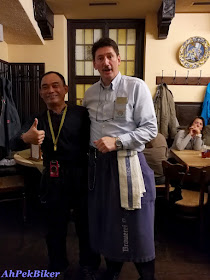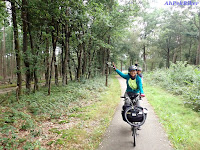AhPek Biker - Riding Adventures
Cycling Europe 2017 Days 12 & 13: Arnhem To Dusseldorf - Cycling Dusseldorf
United Kingdom, France, Belgium, Netherlands & Germany : Days 12 & 13 - Friday & Saturday, 8th-9th September - Arnhem to Dusseldorf
Cycling Distance - 7.27 km. Level: Very easy.
Cycling Time : 10:15am to 3:00pm
Time Taken : 4 hrs. 45 mins. (inclusive of visits to churches, museums, riverside promenade; stops for lunch, and many photo opps).
Route Recommendations :
1. Traffic Directions!
On the Continental Europe, vehicles are left-hand drive, so cycle on the right. And do remember the traffic directions at road crossing. Also note that often cycling lanes run next to pedestrian lanes at town and city areas, at crossings there are separate lanes for pedestrians and bicycles, so stick to the correct lane.
2. Route & Traffic Conditions
For planning cycling routes in Europe, Cycle Travel which has a very user-friendly cycle travel trip planner, routes using this planner can be saved and also converted to GPX format for use in GPS devices.
3. Weather
At Arnhem, the day weather was a cold in the early morning at 12°C and drizzling rain with wind speed averaging 17 kph with gusts up to 30 kph. At Dusseldorf the following day; morning temperatures averaged between 15°C to 19°C with winds speed averaging with intermittent drizzling through out the day. Evening temperature was warmer averaging at 19°C and wind speed averaging 19 kph with gusts up to 30 kph.
It is always prudent to check the weather for the next day so as to know what to expect and be prepared for it. Useful weather forecast sites are BBC Weather, AccuWeather and Weather Spark.
4. Places of Interest
5. Food
8th September -
- Breakfast: Take-away sandwiches and pastries.
6. Accommodations
We stayed two nights at the Bellevue Hotel (GPS: 51.21711, 6.78685) which we had pre-booked online a 3-pax room and a 2-pax at €166 and €128 respectively for two nights.
Address: Luisenstraße 98-100, 40215 Düsseldorf, Germany.
Phone : +49-211384140
7. Bringing Bikes Onto Trains
The European local trains allow any bicycles on board, but there is a fare to be paid for the bicycles. To avoid this, we folded and bagged our bicycles before bringing them into the stations. Details on bringing bikes onto European trains can be obtained from the uk.voyages-sncf.com site.
8. Communicating with Each Other
When travelling in a group it's important to be able to communicate with each other, especially if one got lost.
9. Communicating with Locals
In the Netherlands, almost all the locals can speak English.
When communicating with locals is a problem, this could be partly overcome by using translation apps like Google Translate. Do install this app into your phone and before you leave on your tour do some basic translation as it will be saved onto a list of recent translations.
Look out for the tourist information booths at airports, railway stations or bus stations, the guides manning the booths speak very good English and do give good tips on where to visit, directions, train and bus schedule.
10. Navigation
As Bill had pre-planned the route and had loaded the GPX route file onto his Garmin GPS unit. I was the assistant navigator and had loaded the route maps onto my unit too.
11. Service Your Bicycles & Carry Tools and Spares
Before leaving on your tour, it will be good to service your bike and bring along some spares like tubes, puncture patches, brake pads and the relevant tools.
___________________________________________________________________________________
PRELUDE
The previous day we had cycled from Amsterdam to Arnhem riding along one of the one of the longest dedicated cycling bridge; and at the tail end rode along some pleasant, shady woods before ending our ride at Antonius B&B, which was the best place that we stayed in during our tour.
This next two days we will cross over to Düsseldorf in Germany and spend two nights there.
___________________________________________________________________________________







































































